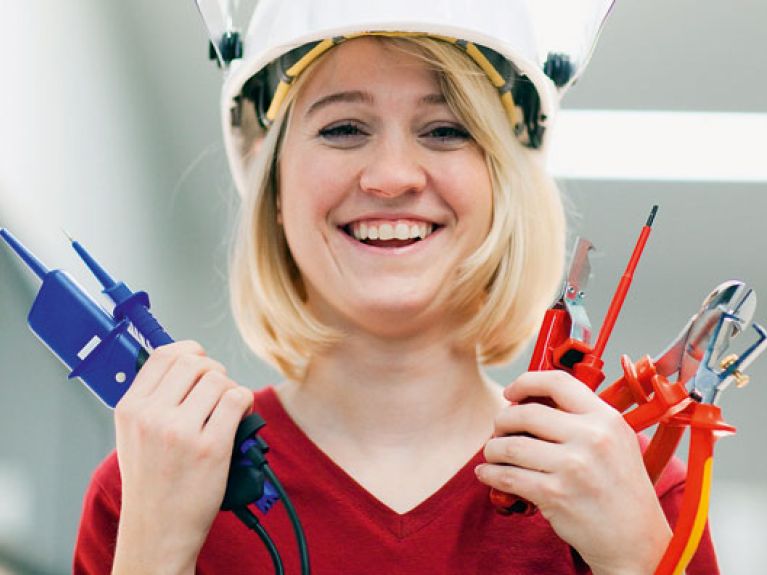Well-trained, German style
Germany’s dual training system is attracting more attention than ever before. More and more countries are using it as a model.

Sergej Majsukow found a job immediately after completing his apprenticeship. In July 2012 the 21-year-old began working in lamp production at Osram, the Siemens subsidiary, in his home town of Smolensk. Such a smooth transition into the world of work is not taken for granted in Russia, because most of the students at vocational schools have hardly any contact with industry. Osram has been offering “dual training” in Smolensk for the last five years. This involves not only theoretical instruction, but also practical work in the workshop and production. “The many practical exercises are important, because they enable us to enter production highly qualified,” says Majsukow.
Smolensk or Budapest, Barcelona or Lisbon, Puebla or Shanghai – all over the world more and more young people are receiving this kind of dual training. China, India, Russia and many countries in Latin America are interested in the tradition-steeped German model. Furthermore, since the advent of the financial and economic crisis demand for information about this system has also increased substantially in the European Union. “The German training system once used to be considered rather exotic,” says Steffen Bayer, head of the unit for Vocational Training Abroad at the Association of German Chambers of Industry and Commerce (DIHK). “That has now changed completely.” The main reason for this is the very high rate of youth unemployment in Europe. On average in the EU roughly one quarter of under-25s is out of work, even rising to over half in Spain and Greece. Internationally, people have come to realize that the dual training system is the main reason why there are comparatively few young unemployed in Germany. Here young people are integrated into the everyday working world from the very start. Government and industry cooperate closely in defining content, quality and examination standards.
Spain is the first country that intends to reorganize its training system on the basis of the German model. The education ministers of Germany and Spain have agreed on stronger collaboration in vocational training. A pioneering role is being played by Seat; the car manufacturer has been running dual training programmes at its Spanish production plants since September 2012. “Over the years the technical standard of our products has developed strongly and so have the level of skills and flexibility we expect from our employees,” explains Seat Executive Vice-President Human Resources Josef Schelchshorn. “The German model of dual training meets these requirements.” In designing its new concept, Seat sought advice from Volkswagen, its parent company. In future, the budding vehicle mechanics, industrial and tool technicians and electronic automation technology technicians will spend roughly half of their three-year training programme in the plant.
The Federal Institute for Vocational Education and Training (BIBB), which researches and develops vocational education in Germany, will support the reorganization of the Spanish training system. BIBB works with some 30 partner institutions worldwide, more than half of them in Europe. Collaboration with many partners has intensified in the last one to two years and new agreements have been concluded with Chile, Colombia and Mexico. “Of course, you can’t transfer the German training model to other countries directly without any changes,” says Michael Wiechert, who is head of the section for International Cooperation and Advisory Services at BIBB. However, his institute can help partners to draw up standards for vocational education and define the role of companies within the statutory framework. “The most important thing is getting industry on board,” emphasizes Wiechert. People abroad are often amazed that companies in Germany bear 70% of the training costs. “But when you want to have people with the right skills at the right place at the right time that pays off for the firms involved.”
Government bodies are not the only organizations promoting the export of the German training system. Many German companies have been active in this field for some time – out of pure self-interest. After all, highly qualified personnel are essential not only for their foreign production plants, but also their suppliers and customers. The initial contacts for companies on this question are German chambers of commerce abroad (AHK), which can be found in 80 different countries. AHKs that have an especially large amount of experience with dual training include the chamber in Shanghai, which has been advising and supporting companies in the region for over ten years, and the chambers in Lisbon and Porto. The latter have been offering practically oriented training programmes for vehicle mechanics, industrial management assistants and specialist hotel personnel in partnership with Portuguese companies for almost 30 years. The centres and training programmes are known throughout Portugal under the “dual” brand name and 90% of the trainees receive permanent contracts at the end of their courses. The model has a good chance of gaining nationwide significance: the Portuguese government also intends to introduce a dual training system in the medium term.
The Siemens Group had to come up with some new ideas in order to meet the demand for new skilled personnel abroad. It does not only offer dual training at many locations like Smolensk: Siemens Technik Akademie has also established a multi-level dual initial and advanced training programme in mechatronics on four continents. Since 2006 the Siemens Mechatronic Systems Certification Program (SMSCP) for young technicians and engineers has been offered, among other places, in the USA, South Africa, India, Malaysia and the UK. Teachers at the partner schools and higher education institutions are trained at the Technik Akademie and then implement the programme in their own countries. The certificate is internationally recognized. Using this method, it has been possible to transfer core elements of the German dual training system to other countries without having to fundamentally change existing training structures, explains Stephan Szuppa, director of the Siemens Technik Akademie: “We believe that this seed will take root and grow.”
Miriam Hoffmeyer

